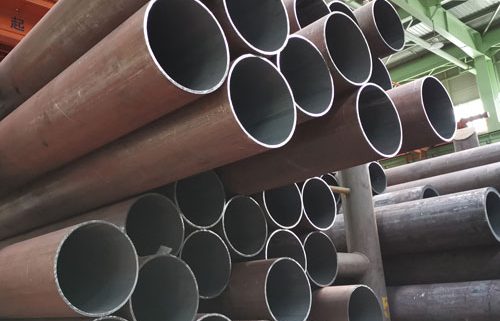Classifications of Carbon Steel Pipes
The material, diameter, wall thickness, and quality of a specific service determine the pipe manufacturing process. Carbon steel piping is classified according to the manufacturing methods as follows:
- Seamless
- Electric resistance weld (ERW)
- Spiral-submerged arc weld (SAW)
- Double submerged arc weld (DSAW)
- Furnace weld, butt-welded, or continuous weld
Seamless pipe is formed by piercing a solid, near-molten steel rod, called a billet, with a mandrel to produce a pipe without seams or joints. The figure below depicts the manufacturing process of seamless pipe.
ERW Steel Pipe
ERW pipe is made from coils that are cupped longitudinally by forming rolls and a thin-pass section of rolls that brings the ends of the coil together to create a cylinder.
The ends pass through a high-frequency welder that heats the steel to 2600 °F and squeezes the ends together to form a fusion weld. The weld is then heat-treated to remove welding stresses, and the pipe is cooled, sized to the proper OD, and straightened.
ERW pipe is produced at individual or continuous lengths and then cut into individual lengths. It is supplied according to ASTM A53, A135, and API Specification 5L.
ERW is the most common manufacturing process due to its low initial investment for manufacturing equipment and its processability in welding different wall thicknesses.
The pipe is not fully normalized after welding, thus producing a heat-affected zone on each side of the weld that results in non-uniformity of hardness and grain structure, making the pipe more susceptible to corrosion.
Therefore, ERW pipe is less desirable than SMLS pipe for handling corrosive fluids. However, it is used in oil and gas production facilities and transmission lines for 26″ (660.4 mm) OD and more prominent lines after normalized or cold expansion.
SSAW Steel Pipe
Twisting metal strips form the spiral-welded pipe into a spiral shape, similar to a barber’s barber and welding, where the edges join one another to form a seam. Due to its thin walls, this type of pipe is restricted to piping systems using low pressures.
SAW or DSAW pipe?
SAW and DSAW pipes are produced from plate (skelp’s), skelp’sare either formed into a “U” and t “e” an “O” and t “e” welded along the straight seam (SS) or twisted into a helix and then welded along the spiral seam (SW). DSAW longitudinal butt joint uses two or more passes (one inside) shielded by granular fusible materials where pressure is not used.
DSAW is used for pipes greater than 406.4 mm nominal. SAW and DSAW are mechanically or hydraulically cold expanded and supplied according to ASTN Specifications A53 and A135 and API Specification 5L. They are supplied in sizes 16″ (406.4 mm) OD to 60″ (1524.0 mm) OD.
LSAW Steel Pipe
LSAW (LSAW) in leaflet plates is raw material, and the steel plate in the mold or molding machine pressures (volume) is usually double-sided submerged arc welding and flaring from production.
A wide range of finished product specifications, weld toughness, flexibility, uniformity, and density, with a large diameter, wall thickness, high-pressure resistance, low-temperature corrosion resistance, etc.. Steel pipe is required to construct high-strength, high toughness, high-quality long-distance oil and gas pipelines, mostly large diameter thick wall LSAW.
API standard provisions, in the large-scale oil and gas pipelines, when 1, Class 2 areas through the alpine zone, the bottom of the sea, the city densely populated area, LSAW only applied specifically casts.




